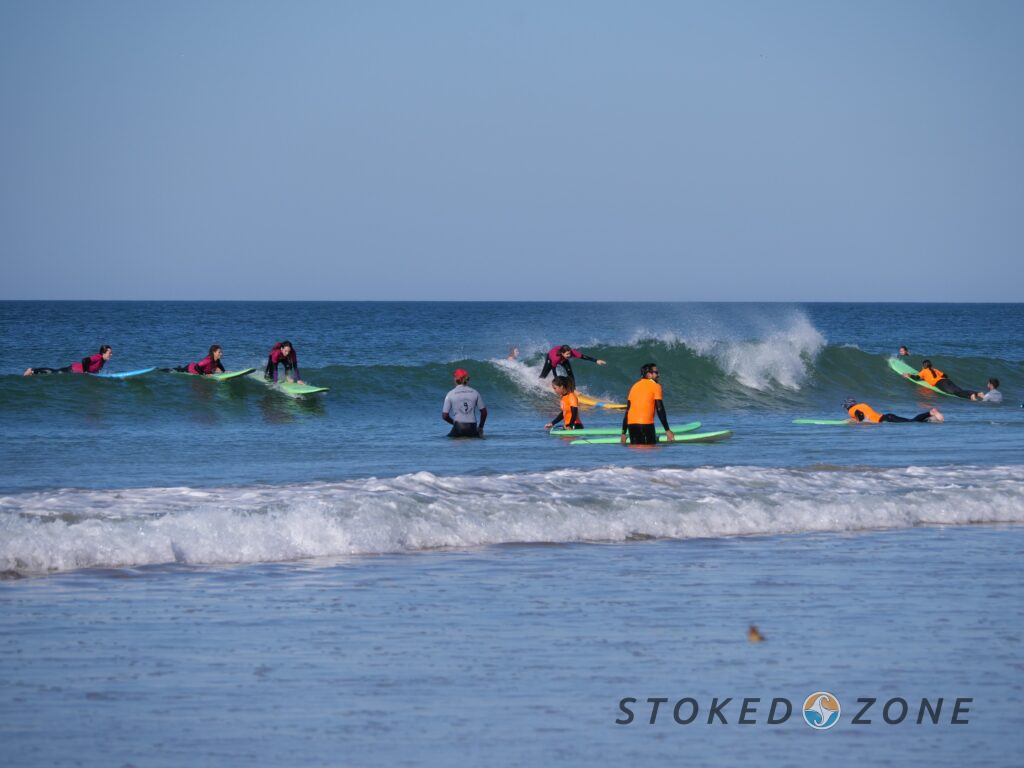
BOOT & FUN Berlin 2024 – We are exhibiting!
Hamburg, 17.11.2024 – After successfully participating in surf festivals in the north of Germany (Fehmarn) and a trade fair in the south,
Below we will introduce you to the essential surf equipment. We give you an overview of everything you need for surfing and provide you with four “golden rules” to ensure that your surf equipment lasts as long as possible.

First things first: It goes without saying that you need a suitable surfboard if you want to immerse yourself in the world of surfing or reach a higher level. When choosing the right surfboard, it’s important to consider your experience and what kind of wave you like to surf the most. Your height and weight also have a significant influence on your choice of surfboard. We have compiled an overview of the most well-known types of surfboards to assist you in making your decision.
Find the right board with us and get a little closer to your surfing dream!
Longboards are considered the originals in the history of surfing. The length is between 8 and 11ft, which creates a lot of buoyancy and stability. Longboards are a little more difficult to handle on the beach and in the water, but beginners can still shine on smaller waves. Longboards are generally associated with an elegant surfing style on endless waves with a Hang of 5 or Hang 10.
Over the years, increasingly shorter boards with various characteristics have been shaped. The Shortboard is widespread and very popular in the surfing world. With a length between 5.1 – 6.6ft and a pointed “nose”, numerous maneuvers and tricks such as snaps, cutback roundhouses, 360s or floaters can be surfed. Shortboards are usually lightweight, easy to handle and facilitate duck diving (diving under the wave). They are the ideal board for advanced and professional surfers and can be surfed in a wide variety of waves.
The Fish surfboard can be recognized by a round nose, the typical swallow tail and plenty of volume. It is suitable for beginners who already have some experience. The shape of the surfboard is also very popular among advanced surfers, as it can be surfed in numerous conditions and offers more control and faster planing than a Shortboard. The Fish is therefore also suitable for North Sea and Baltic Sea waves.
Guns or the slightly shorter Semi-Guns are used for very large waves in “big wave surfing”. You can recognize it by the longer and narrower shape, the thickness and the very pointed “nose” and “tail”. This shape is necessary to maintain maneuverability at higher speeds and to prevent the board from fluttering. Many Guns have four to five fins, which creates stability in huge waves.
A Mini Malibu looks like a shorter version of a Longboard and is the ideal surfboard for beginners. The board has a comfortable length and additional width compared to the Shortboard. In combination with the round “nose,” much more stability is imparted. This can increase the number of waves surfed and promote the learning process.
A Funboard is a mixture of a Mini Malibu and a Fish. Extra volume and length compared to a Fish will help you paddle and surf a wave. The Funboard forgives small mistakes and you can make tighter turns with it than with a Mini Malibu. This makes a Funboard the ideal board for getting to know the world of Shortboards.
The Foamie or Softboard is an ideal board for beginners and children. The risk of being injured by the board is greatly reduced as the entire surface is made of foam. Most surf schools use Foamies in the shape of a Longboard for their surf courses. For children, the Foamie in the shape of a Shortboard is an ideal board for learning to surf. Even professionals such as Jamie O’Brain enjoy Foamies from time to time.
You can use the following formula to calculate the optimum volume in liters for your surfing ability and body weight:

In addition to the surfboard, you will need the following surf equipment:
The invention of the leash makes a huge difference to the surfing experience and safety in the line up. A leash connects the surfer’s foot to the surfboard, allowing for quick retrieval of the board after a wipeout. A strap is used to fasten the leash around your ankle or, in the case of a Longboard, around the knee joint. The leash features a “quick release” function in case it gets tangled somewhere on the seabed, such as a coral reef. The quality of the leash should not be skimped on. It can make the decisive difference in critical situations. This can significantly reduce the chance of the leash breaking and you losing your surfboard. The surfboard has a leash plug where the leash is attached.
The leash should be a maximum of 6” longer or shorter than the length of the board (example: an 8′ leash is suitable for boards between 7’6” and 8’6”). In general, we recommend always keeping the leash a little bit longer. This means that for a 6.6ft Shortboard, for example, you choose 7ft as the leash length.
The surfboard should be stored in a board bag or a board sock, as soon as you finish your surf session and have rinsed your surfboard with fresh water. This way you can be sure that it is protected from sunlight and scratches. Just like numerous different surfboard lengths, there are matching board bags and board socks. In addition, the thicker the padding of the bag, the better your surfboard is protected. A high-quality board bag is particularly worthwhile if you like to travel the world with your surfboard in search of new waves or if you are traveling by plane. The board bag can also be used to store other surf equipment such as neoprene, fins and wax. A wetsuit provides additional padding for your surfboard.
The invention of fins was a milestone in the world of surfing. In the beginning, only a single fin was used to ensure maneuverability.
The result was more experimentation, leading to the invention of the Twin Fin. Today, this variant is very popular for the Fish board. There are also three fins (Thrusters), which is probably the most common option. You get a good combination of stability and the freedom to still maneuver the surfboard with agility.
With a Quad Fin set-up, the surfboard has four fins, as the name suggests. Thrusters tend to have a more predictable and controlled release behavior compared to Quads, and provide a sense of stability in average surf conditions. Quads, on the other hand, are somewhat more unpredictable in turns, but allow, among other things, higher speeds with a tighter turning circle.
Fins are a comprehensive topic, and the choice of type and number of fins primarily depends on personal preference, as well as the shape and height of the waves being surfed.

Over time, a surfer rides, damages, or breaks numerous boards. As a surfer, you are constantly evolving, which means that at certain intervals you will need to buy a new surfboard to suit your needs.
For this reason, it makes sense for beginners to buy a used board first. Therefore, you can find out if the sport is really something for you without having to spend too much money. The same applies to a wetsuit – there are numerous used wetsuits and boards of good quality. The Mini Malibu, Funboard and Softboard are best suited for beginners.
See also our blog“Used surf equipment” – everything about used surf equipment.

Of course, we all dream of tropical waters where we can simply surf in our swimming trunks and bikini. Unfortunately, the reality is somewhat different – many surf breaks are located in the colder climate zones. But the cold water doesn’t put a true surfer off and with the right equipment you can stay warm despite the icy cold. Tip: A proper warm-up routine before plunging into the cool waters is essential. Not only does it make entering cold water much more bearable, but it also helps protect your muscles. Here is the most important neoprene surf equipment.

Wetsuits have different thicknesses. Most neos (or wetsuits) are 2-5 mm thick, with the thickness corresponding to the water temperature. For winter or stormy days, it is also worth wearing a neoprene vest under the wetsuit. Some of these are also available with a hood and provide additional warmth.
There are also various neopren shoes available, which are designed in a way which ensures that you can still move your toes easily.
In cold weather, you should definitely wear neoprene gloves to keep your fingers flexible. The neoprene gloves are available in various thicknesses between 0.5 and 7 mm and in a wide variety of shapes, such as finger gloves, mittens or three-finger gloves. Neoprene mittens are generally warmer than neoprene finger gloves, but have the disadvantage that the freedom of movement and grip of the hands is reduced.

The surface of the surfboard is very slippery, especially in the water, which can be very frustrating when surfing. Surf wax provides more grip and stability, making it much easier for you to stay on the surfboard and perform maneuvers. You can apply the wax either in circular movements or in strips. You can use the jagged side of a wax comb to freshen up old wax if you don’t have any wax with you. With the smooth side, you can dewax your surfboard from time to time so that no lumpy layer accumulates.

Sunscreen is often forgotten, resulting in painful sunburns, especially if you spend several hours in the water. Solar radiation reflects in the water and ensures greater exposure than on land. There are numerous sun creams that are specially made for surfing. This means you can be sure that the sun protection will stay on your skin even during a duck dive or wipeout. In addition, more and more manufacturers are ensuring that the suncream is produced without harmful chemicals in order to protect marine animals and coral reefs.

Relaxing on the beach after surfing and putting your surfboard in the blazing sun or in the car? This is the worst thing you can do to your board!
In a surfboard exposed to high heat, chemical processes can occur that lead to the release of chemical vapours. The resulting pressure inside can cause damage such as bubbles on the surface material or even inflate the board.
For these reasons, you should never keep your surfboard in the car on hot days and cover it with a towel or put it in a sock/board bag on the beach.
While surfing, it’s easy for your board to sustain minor damage, whether in the water or while handling it on land. That’s not a big deal (aside from the cosmetic flaw), as many surfboards have a foam core that hardly absorbs any water. Nevertheless, you should repair your board immediately to avoid consequential damage. At the very least, you should temporarily seal the affected area with a repair kit or tape so that no water can get into the foam core.
We recommend that yourinseyour wetsuit with cold or lukewarm fresh water (never hot water!) after every surfing session, in order to wash out the salt water and keep your equipment for as long as possible. The salt can build up, affect the material, corrode the zipper of the board bag and make it porous until it becomes unusable. You should also rinse your surfboard with fresh water, as the salt crystals and grains of sand can damage the material in the long term.
The wetsuit should also be washed once a while with a care product to avoid poor hygiene and unwanted odors.. For example, use a bucket, the bathtub or wash it in the washing machine on a gentle cycle with a special, mild liquid detergent. Special detergents for wetsuits ensure that your wetsuit does not lose its elasticity and still feels like new for a long time. After washing, you can hang the wetsuit up to dry – but make sure that it is not exposed to direct sunlight.
Tip: Have a look under “Ads” on the Stoked Zone to see if you can find the right used surf equipment for you.
Your Stoked Zone Team

Hamburg, 17.11.2024 – After successfully participating in surf festivals in the north of Germany (Fehmarn) and a trade fair in the south,

Hamburg, 10.12.2024 – Boot & Fun Berlin was another success for the development of the Stoked Zone as a platform for surf sports

Hamburg 25.11.2024 We are very pleased to announce our partnership with the premium surfskate brand Curfboard.Curfboard is a German company with a